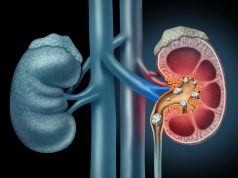2006 to 2014 saw more than doubling in the use of CTAP in the ED, with considerable geographic variation
THURSDAY, June 27, 2019 (HealthDay News) — Among patients with suspected urolithiasis presenting to the emergency department (ED), relative use of computed tomography (CT) of the abdomen and pelvis (CTAP) more than doubled from 2006 to 2014, according to a study published online June 17 in the Journal of the American College of Radiology.
Patricia Balthazar, M.D., from Emory University School of Medicine in Atlanta, and colleagues determined the annual numbers of ED visits for suspected urolithiasis and associated CTAP examinations per visit for all patients from 2006 to 2015 based on the Nationwide Emergency Department Sample. The compound annual growth rate (CAGR) for CTAP was assessed.
The researchers found an increase in the number of ED visits per year for suspected urolithiasis nationwide, from 1,057,119 in 2006 to 1,246,041 in 2014, respectively (relative +17.9 percent); annual CTAP use increased from 24.6 to 49.4 percent per visit (relative, +100.8 percent; CAGR, +8 percent). In multivariate analysis, there were correlations for higher CTAP use with higher patient household income ZIP code quartile (odds ratio for wealthiest/poorest, 1.48), private payer (odds ratios, 1.21 and 1.22 for Medicare and Medicaid, respectively), Northeast geographic region (odds ratios, 5.07 versus Midwest, 4.16 versus West, and 1.77 versus South), hospital urban status (odds ratio, 1.42), and nonteaching hospitals (odds ratio, 1.2).
“These findings provide important information to practicing clinicians, researchers, and policymakers interested in optimizing the use of advanced medical imaging in the ED,” the authors write.
Copyright © 2019 HealthDay. All rights reserved.








